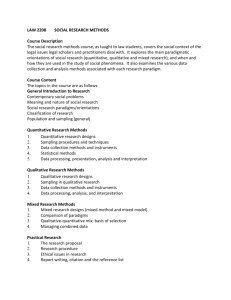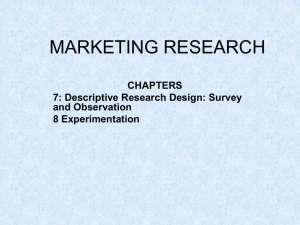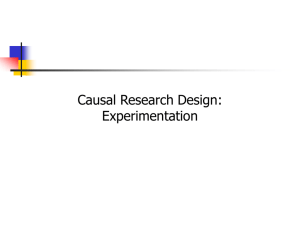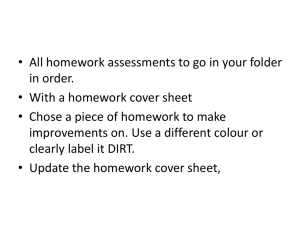The Best Design for the Question
advertisement
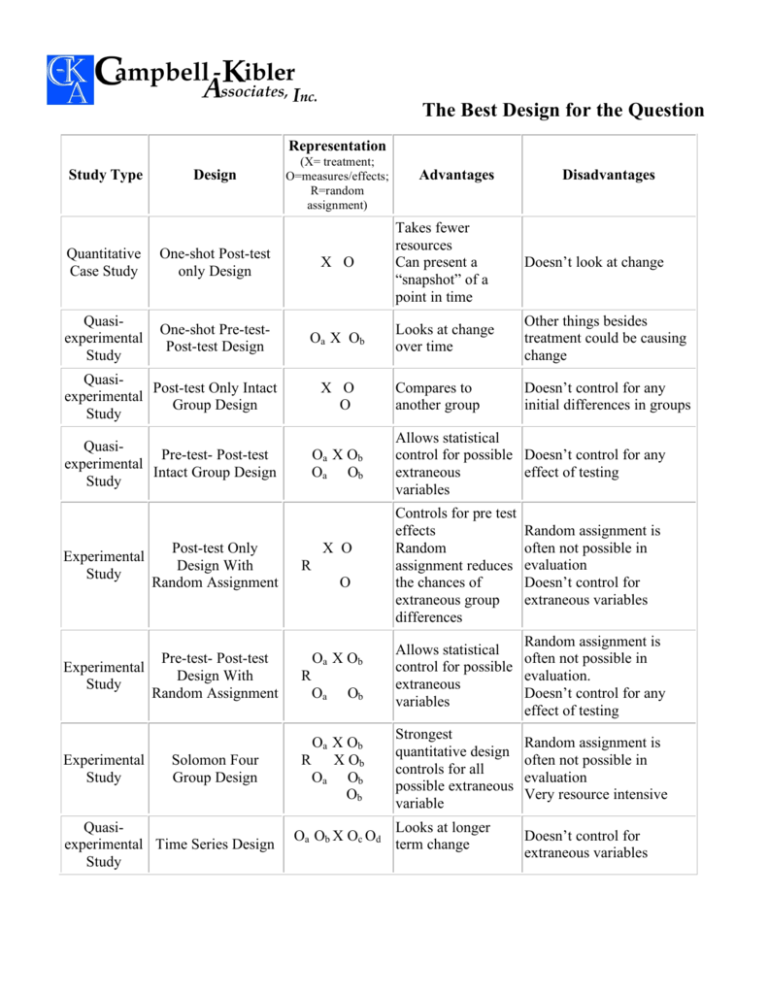
The Best Design for the Question Representation Study Type Design Quantitative Case Study One-shot Post-test only Design Quasiexperimental Study One-shot Pre-testPost-test Design (X= treatment; O=measures/effects; R=random assignment) X O Doesn’t look at change Oa X Ob Looks at change over time Other things besides treatment could be causing change Compares to another group Doesn’t control for any initial differences in groups X O O QuasiPre-test- Post-test experimental Intact Group Design Study Oa X Ob Oa Ob Experimental Study Experimental Study Post-test Only Design With Random Assignment Pre-test- Post-test Design With Random Assignment Solomon Four Group Design Quasiexperimental Time Series Design Study Disadvantages Takes fewer resources Can present a “snapshot” of a point in time QuasiPost-test Only Intact experimental Group Design Study Experimental Study Advantages X O R O R Oa X Ob Oa Ob Oa X Ob R X Ob Oa Ob Ob Oa Ob X Oc Od Allows statistical control for possible Doesn’t control for any effect of testing extraneous variables Controls for pre test effects Random assignment reduces the chances of extraneous group differences Random assignment is often not possible in evaluation Doesn’t control for extraneous variables Random assignment is Allows statistical often not possible in control for possible evaluation. extraneous Doesn’t control for any variables effect of testing Strongest quantitative design controls for all possible extraneous variable Looks at longer term change Random assignment is often not possible in evaluation Very resource intensive Doesn’t control for extraneous variables Participant observer examination of Ethnography group behaviors and patterns NA Explores complex effects over time Resource intensive Story telling approach may limit audience Potential observer bias NA Provides an indepth view Elaborates on quantitative data Limited generalizability Content Analysis Systematic identification of properties of large amounts of textual information NA Looks directly at communication Allows for quantitative and qualitative analysis Tends too often to simply consist of word counts Can disregard the context that produced the text Mixed Methods Study Use of more than one of the above designs NA Can counteract the disadvantages of any one design None Exploration of a case Case Study (or multiple cases) over time Adapted from: Donald T. Campbell and Julian C. Stanley, Experimental and Quasi-Experimental Designs for Research (Chicago: Rand McNally, 1963). Gary Inersoll, Experimental Methods (in Encyclopedia of Educational Research (Fifth Edition); Harold Mitzel ed. New York: The Free Press 1982. pp 624-631. Lydia’s Tutorial Qualitative Research Methods http://www.socialresearchmethods.net/tutorial/Mensah/default.htm Accessed April 15, 2007. Writing@CSU http://writing.colostate.edu/index.cfm Accessed April 15, 2007. Resources on Design Research Methods Knowledge Base: Design http://www.socialresearchmethods.net/kb/design.php A short, but comprehensive, on-line overview of quantitative designs covering the following areas: Introduction to Design Types of Designs Experimental Design Quasi-Experimental Design Relationships Among Pre-Post Designs Designing Designs for Research Advances in Quasi-Experimentation Research Methods Knowledge Base: Types/Traditions of Qualitative Research http://www.socialresearchmethods.net/tutorial/Mensah/default.htm A short, but comprehensive, on-line overview of quantitative designs covering the following areas: Biography Phenomenology Grounded Theory Ethnography Case Study Protection of Human Subjects http://ohsr.od.nih.gov/cbt/cbt.html Short computer-based training, from the National Institutes of Health, on protecting human subjects, one for people who are doing research and/or evaluation and one for people who are members of institutional review boards. Some Web-based Sources of Resources User Friendly Guide to Program Evaluation http://www.nsf.gov/pubs/2002/nsf02057/start.htm Introduction Section I - Evaluation and Types of Evaluation Section II - The Steps in Doing an Evaluation Section III - An Overview of Quantitative and Qualitative Data Collection Methods Section IV - Strategies That Address Culturally Responsive Evaluations Other Recommending Reading, Glossary, and Appendix A: Finding An Evaluator OERL, the Online Evaluation Resource Library. http://oerl.sri.com/home.html Includes NSF project evaluation plans, instruments, reports and professional development modules on Designing an Evaluation Developing Written Questionnaires Developing Interviews Developing Observation Instruments Data Collection Instrument Triangulation and Adaptation. Sample Under-represented Student Instruments From OERL include: Attitude Surveys Content Assessments Course Evaluations Focus Groups Interviews Journal/Log Entries Project Evaluations Surveys Workshop Evaluations AGEP Collecting, Analyzing and Displaying Data http://www.nsfagep.org/CollectingAnalyzingDisplayingData.pdf I. Make Your Message Clear II. Use Pictures, Where Appropriate III. Use Statistics and Stories IV. Be Responsive to Your Audience. V. Make Comparisons VI. Find Ways To Deal With Volatile Data VII. Use the Results ETS Test Link (a library of more than 25,000 measures). http://www.ets.org/portal/site/ets/menuitem.1488512ecfd5b8849a77b13bc3921509/?vgnextoid=ed462d36 31df4010VgnVCM10000022f95190RCRD&vgnextchannel=85af197a484f4010VgnVCM10000022f9519 0RCRD
